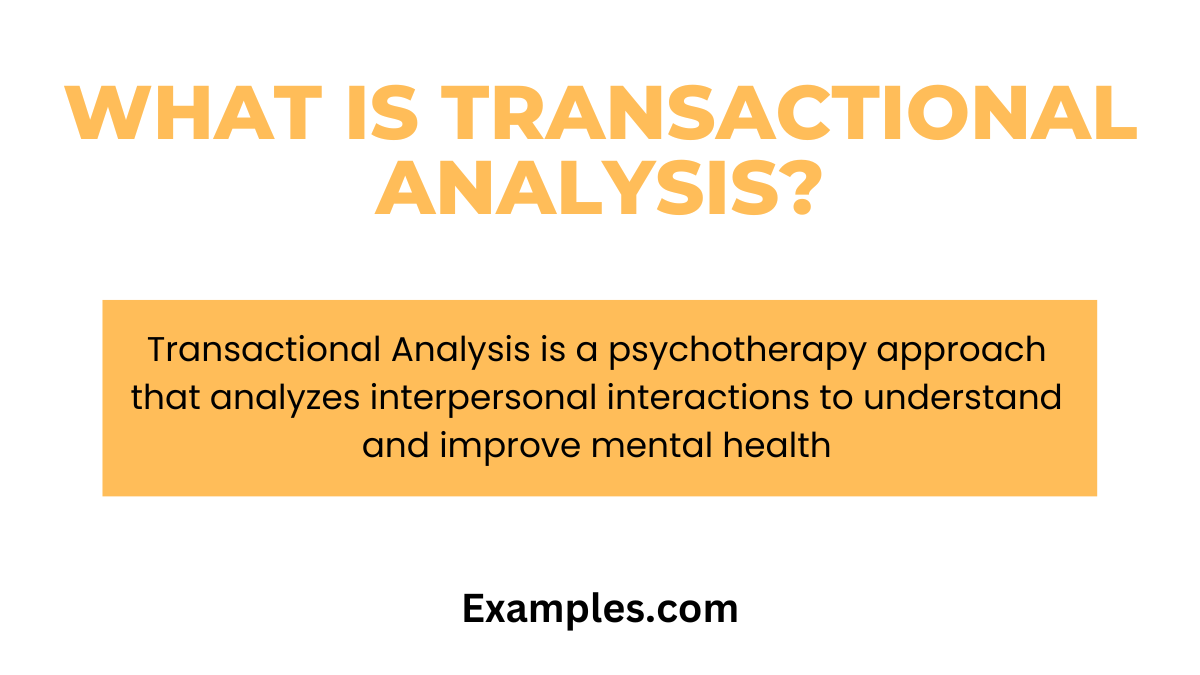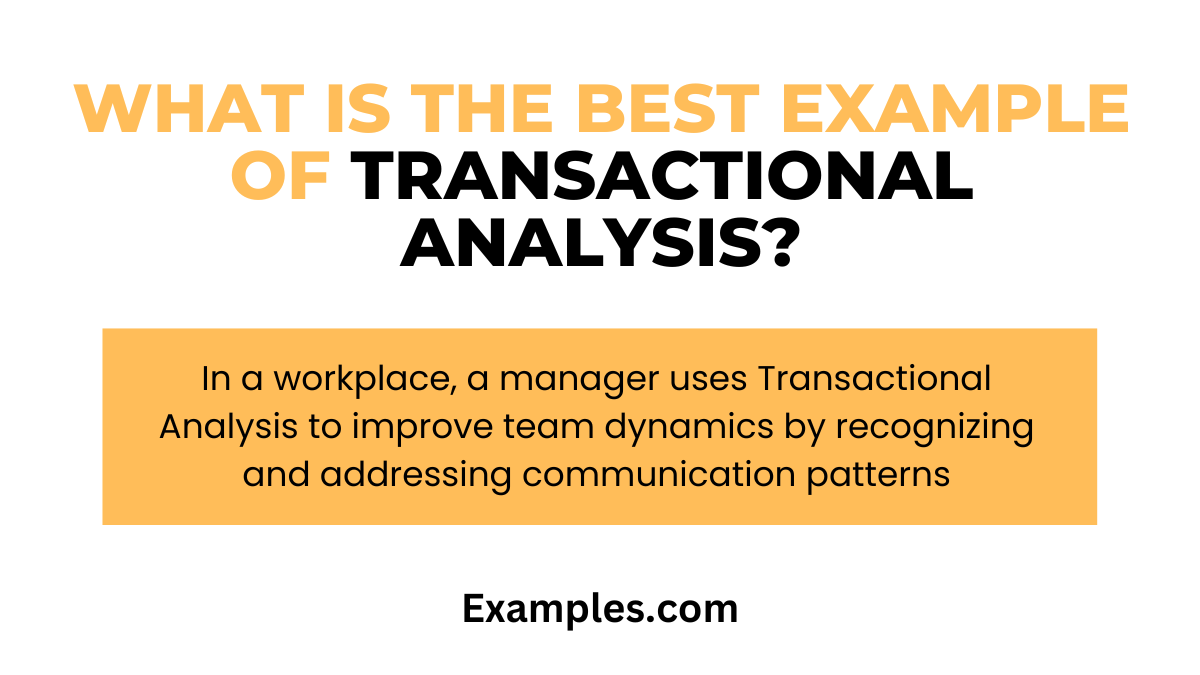19+ Transactional Analysis Examples
Transactional Analysis, a fascinating approach to understanding human interactions and communication, offers a powerful tool for personal and professional growth. This guide delves deep into the intricacies of Transactional Analysis, uncovering its fundamental concepts, practical applications, and transformative impact. Whether you’re a beginner or well-acquainted with the subject, our detailed exploration provides valuable insights and actionable tips to harness the full potential of Transactional Analysis in everyday life.
What is Transactional Analysis?

Transactional Analysis is a psychoanalytic theory and method of therapy wherein social transactions are analyzed to determine the ego state of the communicator as a basis for understanding behavior. This approach helps in identifying and changing unproductive patterns in communication and behavior, leading to healthier relationships and personal growth.
History
Who Created: Eric Berne
Date: 1950
TA is a psychoanalytic theory that focuses on interpersonal relationships and communication. Berne’s ground breaking book, “Games People Play,” introduced the concept to the public. TA posits that individuals have three ego states – Parent, Adult, and Child – which influence their interactions. Berne’s work emphasized the analysis of social transactions and the recognition of psychological games people engage in during interactions. TA has since been applied in various fields, including psychology, counseling, and organizational development, to improve communication and understand human behavior.
What is the Best Example of Transactional Analysis?

A classic example of Transactional Analysis is the interaction between a ‘parent’ ego state and a ‘child’ ego state. For instance, a boss (parent) giving instructions in a nurturing manner to an employee (child), who responds with creativity and eagerness. This dynamic demonstrates how Transactional Analysis can foster productive and positive interactions.
20 Examples of Transactional Analysis
Transactional Analysis (TA) is a theory of personality and social interactions, offering a framework to understand human behavior in personal and professional settings. It’s a valuable tool for enhancing communication, fostering personal growth, and improving relationships. Here are 20 distinct examples, each with a two-line explanation and example sentences to illustrate the concept:
- Parent-Adult-Child Model: TA’s core model divides communication into three ego-states: Parent, Adult, and Child.
Example: “When you scold like that, you’re in your Parent ego-state; let’s try Adult-to-Adult conversation instead.” - Life Scripts: These are unconscious pathways pre-determined in childhood, influencing behavior in adulthood.
Example: “He always needs approval because his life script tells him he’s not good enough.” - Strokes and Transactional Units: Strokes are units of recognition, while transactional units are basic communication exchanges.
Example: “A smile or a compliment is a positive stroke that can brighten someone’s day.” - Rackets and Stamps: Rackets are emotional games played to elicit a certain response, and stamps are accumulated feelings.
Example: “She’s playing a racket by acting helpless to get attention.” - Games in TA: These are dysfunctional behavioral patterns to gain strokes.
Example: “Playing the ‘I’m always the victim’ game avoids personal responsibility.” - The Drama Triangle: Involves roles of Victim, Persecutor, and Rescuer in communication games.
Example: “He plays the Rescuer, but it often shifts to Persecutor when not appreciated.” - Autonomy: The development of self-awareness, spontaneity, and the capacity for intimacy.
Example: “Gaining autonomy in TA helps you break free from your life script.” - Intimacy Blocks: Barriers in TA that prevent authentic intimacy in relationships.
Example: “Her fear of vulnerability is an intimacy block, stopping her from forming close relationships.” - Crossed Transactions: Miscommunication where two people communicate from different ego-states. Example: “A crossed transaction occurs when one speaks from the Adult ego-state and the other responds from the Child.”
- Complementary Transactions: Harmonious interactions where ego-states align.
Example: “Their conversation flows smoothly because they’re both communicating from their Adult ego-states.” - Discounting: Minimizing or ignoring significant aspects of reality in communication.
Example: “By discounting her achievements, he’s playing a TA game to keep her in a Child state.” - Symbiosis in TA: A dysfunctional relationship where two individuals act as complements to each other’s needs.
Example: “Their symbiotic relationship has him always rescuing her, reinforcing her victim stance.” - Injunctions in TA: Negative parental messages internalized in childhood.
Example: “Her ‘Don’t succeed’ injunction stops her from pursuing her goals.” - Decisions in TA: Choices made in childhood that affect adult behavior.
Example: “His decision to always please others leads to a loss of personal identity.” - Redecision Therapy: A TA method to revisit and change early decisions.
Example: “Through redecision therapy, she overcame her fear of failure.” - Time Structuring: Analyzing how individuals structure their time to understand behavior patterns. Example: “He spends most of his time in withdrawal, avoiding real connections.”
- Passivity in TA: Behavior that relinquishes control to others.
Example: “Her passivity in relationships is a TA trait stemming from her childhood.” - Contamination and Exclusion: Concepts in TA where Adult ego-state is compromised by Parent or Child states.
Example: “His decisions are often contaminated by his Parent ego-state, making them biased.” - Structural Analysis: Studying the individual’s personality through their ego-states.
Example: “Structural analysis reveals her dominant Parent ego-state, explaining her controlling behavior.” - Psychological Games Analysis: Identifying and understanding the games people play in relationships. Example: “Recognizing the ‘Yes, but’ game helps avoid futile arguments.”
How Was Transactional Analysis Developed?
Transactional Analysis (TA) is a psychoanalytic theory and method of therapy wherein social transactions are analyzed to determine the ego state of the communicator as a basis for understanding behavior. This method was developed in the following ways:
- Origin by Eric Berne: Developed in the late 1950s by Canadian-born psychiatrist Eric Berne, TA was born from his dissatisfaction with the slow pace and abstract nature of psychoanalysis.
- Influence of Freud’s Theories: Berne’s work was significantly influenced by Freud’s theories of personality, integrating aspects of the human psyche as the Id, Ego, and Superego.
- Introduction of Ego States: Berne introduced the concept of three clear and concise ego states: the Parent, Adult, and Child. This was a breakthrough in simplifying complex psychoanalytical concepts.
- Book “Games People Play”: In 1964, Berne’s publication of “Games People Play” brought TA to mainstream attention. The book categorized common patterns of social interaction, or “games,” in a comprehensible manner.
- Evolution and Acceptance: Over the years, TA has evolved and been accepted in various fields, including psychotherapy, counseling, education, and organizational development.
What Are the Ego States of Transactional Analysis?
The ego states of Transactional Analysis are a central aspect of this theory, providing a framework for understanding interactions and communication:
- Parent Ego State: This state embodies the attitudes, behaviors, and values copied from parents or parent figures. It’s characterized by guiding, nurturing, and sometimes critical behaviors.
- Adult Ego State: The Adult ego state is about dealing with the present moment in a rational and pragmatic manner. It’s concerned with direct responses to stimuli, devoid of emotional baggage.
- Child Ego State: This state represents the reliving of childhood experiences. It’s spontaneous, emotional, and creative, often displaying childlike qualities in various scenarios.
- Interactions Among States: In TA, interactions are seen as exchanges between people’s ego states. Understanding these dynamics can lead to healthier communication and relationships.
- Diagnostic and Therapeutic Tool: Recognizing which ego state is dominant in a transaction can be a powerful diagnostic and therapeutic tool, allowing for more effective communication strategies.
When to Use Transactional Analysis?
Transactional Analysis is a versatile tool used in various settings:
- Psychotherapy and Counseling: TA is widely used in therapy to help clients understand their behavior and interactions with others, and to develop healthier communication patterns.
- Organizational and Business Contexts: In the workplace, TA can enhance communication among team members, improve leadership skills, and resolve conflicts effectively.
- Educational Settings: Teachers and educators can use TA to understand student behaviors and create a more positive learning environment.
- Personal Development: Individuals can use TA for self-awareness and personal growth, enhancing their interpersonal relationships.
- Conflict Resolution: TA is effective in resolving conflicts by helping parties understand the underlying ego states influencing their interactions.
Types of Transactional Analysis

Transactional Analysis is applied in several ways, each serving different purposes:
- Structural Analysis: This type involves examining the three ego states (Parent, Adult, Child) to understand an individual’s personality structure.
- Transactional Analysis Proper: This type focuses on the dynamics of social transactions and communication between individuals.
- Game Analysis: Here, repetitive and problematic patterns of behavior (games) are identified and analyzed.
- Script Analysis: This analysis looks at life scripts that people may follow unconsciously, which were developed early in life.
- Organizational Transactional Analysis: Specifically applied in business and organizational settings, this type focuses on improving communication and organizational culture.
- Racket Analysis: Racket Analysis in Transactional Analysis identifies recurring emotional responses and behaviors, uncovering their origins and impacts.
- Strokes Analysis: Strokes Analysis examines how individuals seek and accept recognition or attention, addressing validation in relationships.
- Phenomenological Analysis: Phenomenological Analysis delves into one’s subjective experiences and meanings, fostering self-awareness and personal growth.
Transactional Analysis is essential for effective communication. This guide has provided valuable insights and practical tips on writing about this theory. Remember to apply its principles in various interpersonal contexts, fostering healthier relationships and clearer communication. Utilize ego states, transactions, and scripts to analyze and improve interactions, ultimately enhancing your interpersonal communication skills.



